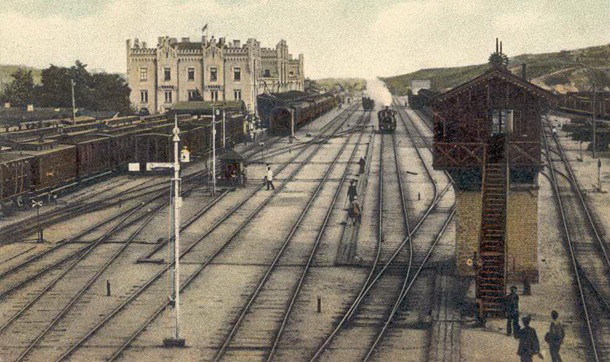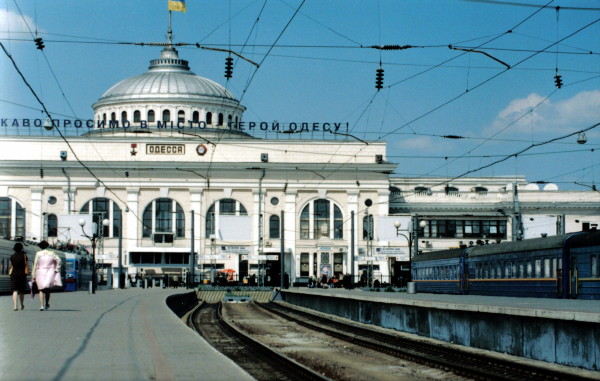Railroad transportation
Railroad transportation. In Ukraine railroads are a major mode of transportation. Because the natural waterways lie from north to south, the east–west traffic must be borne by land transportation, in which railways played the dominant role. The lower cost of railroad building and maintenance gives them an advantage over motor vehicle transport. Ukraine’s railroad network was developed by the imperial powers that controlled its territories and served the interest of the imperial economies, not Ukraine’s economy.
The first railroad line in Ukraine, built in 1861, connected Lviv, Cracow, and Vienna. Later the line was extended southward toward Chernivtsi, in Bukovyna (1866), and eastward to Brody and Pidvolochysk (1867–71). By the turn of the century nine lines had spread rapidly from Lviv, the largest rail center in Western Ukraine. The other main junctions, with five lines each, were Stanyslaviv, Stryi, and Ternopil. The first railroad in Russian-ruled Ukraine was built in 1865. It ran from Balta to Odesa. In 1868 it was extended to Yelysavethrad and from there through Kremenchuk to Kyiv (1872). By then Kyiv had been connected by rail to Moscow (1869). In the 1870s the Moscow–Kursk–Kharkiv line was extended south to Lozova, and then branched out to Rostov-na-Donu and Sevastopol. In 1870 Kyiv was connected with Odesa through Zhmerynka and with Moscow through Konotop. In 1880 to 1890 numerous trunk lines were constructed to connect the Donets Basin with the Kryvyi Rih Iron-ore Basin and the newly established heavy-industry complexes at Katerynoslav and Oleksandrivske. By 1914 several other main lines, including the Mykolaiv–Bakhmach, Kyiv–Donbas, Kyiv–Warsaw, and Fastiv–Katerynoslav, were built. The railways in central and eastern Ukraine carried mostly wheat to the seaports for export and raw materials to the rapidly growing industry in the Dnieper region and in Russia. By 1913 Ukraine had approximately 15,600 km of rails, some of them double-track trunk lines. Lines were built without any general plans, so that some important cities, such as Radomyshl, Bobrynets, and Pereiaslav, were left without rail service. The physical plant, rolling stock, and carrying capacity of the railways were well below European standards. The Ukrainian-Soviet War (1917–21) destroyed much of the railroad network in Ukraine.
In the interwar period the Soviet regime built some lines that had been planned before the First World War, including the Kharkiv–Dnipropetrovsk–Kherson, Fastiv–Novohrad-Volynskyi–Zhytomyr, Chernihiv–Horodnytsia, and Pavlohrad–Hryshyne lines and several short links in the Vinnytsia and Kyiv regions serving the sugar industry. A number of short lines in the heavily industrialized Dnieper-Donets region were opened to relieve congestion on the trunk lines, such as Fedorivka–Snihurivka in the Kherson region, Vesele–Dniprorudne in the Zaporizhia region, Dolynska–Pomichna in the Kirovohrad region, Novomoskovsk–Dniprodzerzhynsk in the Dnipropetrovsk region, and Horlivka–Ocheretyne in the Donets Basin. Many of the new lines had a special purpose and were restricted to a certain industry or enterprise. Altogether about 4,000 km of track were added to Ukraine’s network. During the Second World War over 9,200 km of track were destroyed. Ukraine’s railways returned to their prewar capacity only in 1948. No new lines were built; instead some old ones in the heavily populated areas of Western Ukraine were shut down. To stimulate trade with Western Europe the Lutsk–Ustyluh line was rebuilt in the 1980s.
For a country of its size Ukraine’s railroad network is inadequate. At present the two major junctions in Ukraine are Kharkiv and Lviv, with eight railroad lines each. Kyiv, Bakhmach, Kupiansk, Yasynuvata, Pokrovsk, Korosten, Kovel, Shepetivka, Stryi, Ternopil, and Pomichna are five-line junctions. Many other important junctions are small towns, such as Koziatyn, or even villages, such as Hrebinka and Romodan. Ukraine’s capital, Kyiv, has only one terminal, which until 1933 was a wooden structure. Kharkiv has three terminals; Lviv, Odesa, Poltava, and Dnipro have two terminals each.
Since the 1950s the railway network had been expanded and improved. Many trunk lines have been double-tracked, and approximately 7,800 km have been electrified. With the exception of some local lines, all lines use either electric or diesel power. Lines linking Ukraine with other republics of the former Union of Soviet Socialist Republics and international lines, such as the Kyiv–Lviv–Chop, Koziatyn–Kovel, and Lviv–Odesa lines, are double-track and electrified. The heavily used Kyiv–Konotop trunk line is being rebuilt into a three-track main line. Modern tracks consisting of heavier rail (R-100 instead of R-50 or R-75), a solid ballast-type bed, concrete ties, and deep side ditches for drainage have a higher load capacity. Containers and longer cars with eight instead of four axles have been introduced. More powerful locomotives make it possible to pull heavier loads at higher speeds. By European standards train speeds are still quite low: the technical speed is approximately 55 km/hr, and sectional speed is 45 km/hr. Most locomotives used in Ukraine are built at its own locomotive works (see Locomotive industry). Major repair shops are located in Luhansk, Popasna, Dnipro, Odesa, Lviv, and Stryi.
With minimal capital outlays Soviet railroads were run to the point of exhaustion. Whereas Western railroads require sizable government subsidies, Soviet railroads were profitable with an index of efficiency between 0.75 and 0.85.
The Soviet Ukrainian system suffered less from obsolete or outdated rolling stock than from managerial incompetence. Infrequent train runs, empty freight runs, poor traffic distribution, and lower locomotive working time were the main sources of inefficiency. Suburban traffic had its own problems. The major one was the irregularity of traffic.
Ukraine was divided into six railroad directorates: Donets, Dnipro, Southern, Lviv, Southwestern, and Odesa. The directorates enjoyed some autonomy in planning and regulating rail traffic and services, but capital for the construction of new railroads and basic improvements was controlled by the central government in Moscow.
Table 1 shows that traffic density was distributed unevenly. The Donets railroad had the highest traffic density in the USSR network. The Dnipro railroad was export-oriented, with freight density much higher than the network’s average. The Southern railroad was plagued with great irregularities of traffic flow; it had a high percentage of empty runs. The Southwestern railroad had a significant transit traffic, but its freight flow was close to equilibrium level. The Lviv railroad was a transit-type directorate with traffic irregularities close to the former USSR average. The Odesa railroad was known for its large share of imports and a traffic irregularity close to 50 percent.
Emil Bej
[This article originally appeared in the Encyclopedia of Ukraine, vol. 4 (1993).]



.jpg)